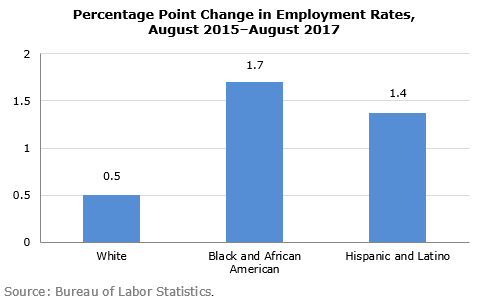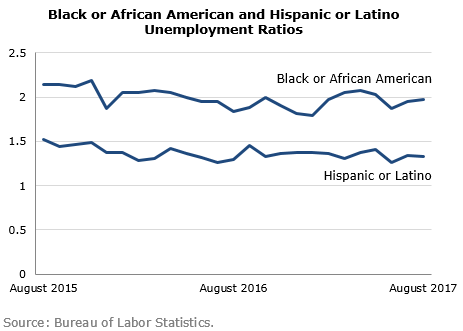September 07, 2017
Two years ago, in August of 2015, the national unemployment rate stood at 5.1 percent. This was at or below widely accepted estimates of the non-accelerating inflation rate of unemployment or NAIRU. This meant that if these estimates were right, the inflation rate would start to increase if the unemployment rate fell further or possibly even if it stayed at its 5.1 percent level.
As it turns out, the unemployment rate has continued to fall and stood at 4.3 percent in August of 2017. Inflation has remained steady or even fallen slightly. By all measures, it is below the 2.0 percent rate targeted by the Federal Reserve Board.
Many economists, including some at the Fed, wanted to raise interest rates enough to prevent any further decline in unemployment out of concerns over inflation. Fortunately, the Fed did not go along with this position.
While the further 0.8 percentage point decline in the unemployment rate itself implies a substantial benefit for millions of workers, it is important to recognize that it is disproportionately the most disadvantaged groups that benefit from lower unemployment.
Figure 1 below shows the increase in employment rates (the percentage of people over age 16 who are employed) for whites, blacks, and Hispanics over the last two years.[1]

While the employment rate for whites increased by 0.5 percentage points over this two year period, it increased by almost 1.4 percentage points for Hispanics and by 1.7 percentage points for blacks. These groups have been disproportionate beneficiaries of the drop in unemployment over this period.
Figure 2 shows the same story from a slightly different perspective. It shows the ratios of the blacks and Hispanic unemployment rates to the white unemployment rate. As can be seen, this ratio moved down over this period from both groups. It started at over 1.5 to 1 for Hispanics, dropping to 1.3 to 1 in the most recent month’s data. For blacks, the decline was 2.1 to 1 to just under 2.0 to 1.

It is important to keep these patterns in mind as the Fed considers its interest rate policy going forward. Further declines in unemployment will disproportionately benefit the most disadvantaged groups in society. This should be a strong argument for the Fed to be very cautious in raising interest rates. While inflation can be a problem, that is not the case now and does not seem likely to be the case in the foreseeable future. In this situation, the Fed should focus on trying to get the unemployment rate as low as possible so that the groups who have thus far been denied the benefits of the recovery will have a chance to get jobs.
[1] The chart takes the average employment rate for June, July and August of each year.






